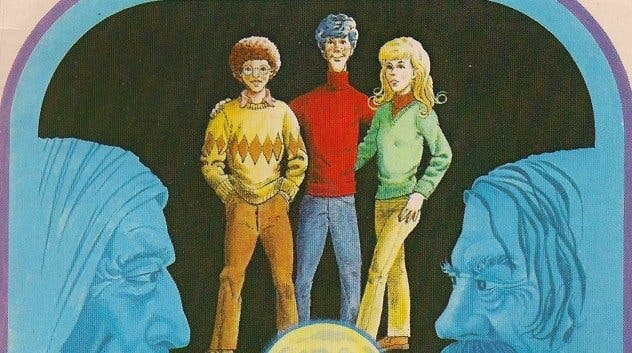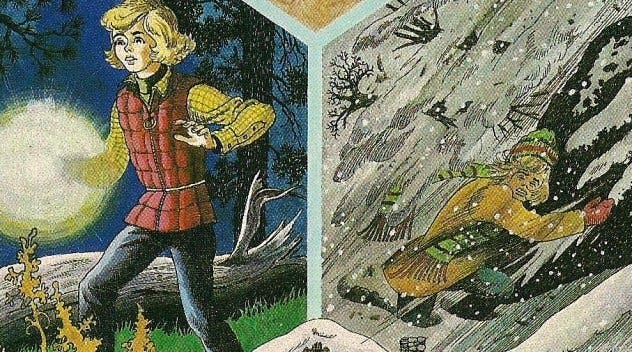Choose Your Own Adventure
(A Choose Your Own Adventure)
THE VIDEO GAME CONNECTION
“There is a trade-off there”
“Are you at all interested in video games?” you ask Packard, towards the end of your chat. “Do you see any connections between the books and the games?”
“I haven’t spent much time with video games,” he admits. “There are some that are educational; others are just fun. I think kids (and grownups) should be careful not to get addicted to them. This doesn’t mean there’s anything wrong with them as long as they’re not overly violent or sadistic. It’s just that we all have limited time and we should give a lot of thought to how we allocate it.”
“Video games sometimes really struggle with telling interesting, involving stories that still allow for choice,” you say. “Do you think there’s anything in your approach to interactive fiction that could be useful to game designers?”
“Maybe,” Packard replies. “My U-Ventures apps, which are interactive books with video game elements, have more text in them than in the original printed books. For decision-making to be meaningful, you have to have fairly rich contexts and complexities so that the reader or player has something to think about. I don’t know how many video games do that.”
You’ve got one last question, and you’ve been waiting to ask it for a while. Did Packard ever develop a perfect one-size-fits-all framework for the books? “I tended to have more narrative and fewer endings,” he says finally. “There is a trade-off there. It’s fun to have a great number of endings, but if you want to develop the narrative and the characters, you need to have more narrative before choices are given and this results in fewer endings. I wouldn’t say that there is an optimum framework.”
You’ve probably heard David Cage say something not entirely dissimilar. Or Ken Levine or the BioWare doctors, for that matter. Strong narratives and lots of choices seem to grind against each other a little. If you got into this, then – like I did - hoping Choose Your Own Adventure might have a magic recipe for interactive fiction that could spread to games, hoping it would end a discussion about games and narrative that you’ve maybe always found a little bit tedious, you’ll be disappointed. There is no magic recipe. There are interesting similarities, but there are also massive, gaping differences. The Choose Your Own Adventure series are still books at the end of it all, and video games often have more in common with science experiments than they do with books.

Part of it comes down to budget. Packard and Co. only had to spend words to build worlds, whereas games need artists, engineers, designers, tech, free soda, and an HR department. You can’t throw ideas around as cheaply when you’re set up like that, so you can’t be as loose, as wastefully inventive, with your stories.
And partly it’s down to player expectation, too. Choose Your Own Adventure books could give you a few choices every other page. We, meanwhile, often aren’t happy with just one choice or two whenever the designer sees fit to give them to us. Video games measure choice in degrees, and it’s a rare player who doesn’t want the full 360.
Some of the very best games give you 360 degrees of choice in most situations, but they aren’t – by and large – the kind of games that also want to tell you stories. Instead, they’re the kind of games that allow you to tell stories – and maybe that’s a crucial distinction.
Take Crackdown. I love it, but I’ll willingly admit that it’s not one of video games’ best stories. There’s little in the way of exposition, emotion, character, or any of that kind of resonance stuff, and I very much doubt little children will ever ask to hear about the war between the Volk and Shai Gen once more before they go to sleep.
As a vehicle for telling stories, though – as an engine for a certain kind of narrative – it’s an absolute masterpiece. You’re not necessarily creating stories tied into its fiction, however: you’re creating stories rooted in its mechanics and geography.

So a Crackdown story goes like this. Yesterday, I was hiding behind a truck, and I was down to my last few bullets. The mob was moving in on me, and my health bar was disappearing in big hungry gulps. A punk surprised me from the left and I kicked him into the sea. Miraculously, that one kick was all I needed to power up my strength to the next level, and I was suddenly able to lift the truck I was crouched behind and lob it down the street, taking out all my enemies at once. (Then I went up the Agency Tower again and jumped off, obv.)
That’s a videogame story: a story where the fun is in the writing of it. That surprise chain reaction in Drop7 - the one that saves you when you’re just about to go off the top of the screen - is another great videogame story. Tetris, Just Cause, Geometry Wars: unexpected triumph, hilarious failure, things getting spectacularly out of hand. These are the video game versions of Icarus, Cinderella, The Good Samaritan and all those other old chestnuts that crop up on cinema screens and bookstore shelves each year as Titanic, or as The Devil Wears Prada.
Perhaps the best video game narratives need you as the writer rather than the reader, in other words. It’s a topsy-turvy kind of idea, for certain, and one that may have many of us got that first, fleeting glimpse of in things like the Choose Your Own Adventure books. They’re the past and sand box games, for me, at least, are the present. The question then, is the same as it always was:
Where do you want to go next?
